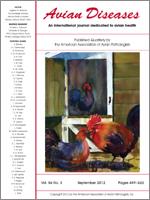Fertilized eggs were obtained from four pairs of sun conures (Aratinga solstitialis) infected with avian bornavirus (ABV) genotype 2, as determined by the sequence of the P24 gene. ABV RNA could be detected in early embryos of all four pairs. ABV RNA also was detected in brain, liver, and eyes of late-stage embryos of one of the pairs (Pair 4) and in blood of a 2-wk-old hatchling of this pair, demonstrating that vertical transmission can occur. ABV RNA could be detected in the liver but not in the brain or eyes of the late-stage embryos of another pair (Pair 3). Although it could be detected in the undeveloped eggs of the female parent and 8-day-old embryos, bornaviral RNA could not be found in the brain and liver of the late-stage embryos or in feathers and blood of young (5–9-wk-old) hatchlings of a third pair (Pair 2). At 11 wk, ABV RNA could be detected again in feathers and blood of these hatchlings and in the brain of one of the hatchlings of Pair 2 that suddenly died. ABV RNA could however be detected in throat swabs of the 5- and 9-wk-old hatchlings and their parents (Pair 2). Although the continued presence of ABV RNA in feathers and blood below the detection level of the reverse transcription-PCR used cannot be excluded, this result also may be attributable to feeding by the infected parents. Analysis by enzyme-linked immunosorbent assay showed that egg yolks and serum of late-stage embryos contain variable amounts of non-neutralizing anti–ABV-P40, -P10, -P24, and -P16 antibodies, the ratio of which reflected the antibody ratio in the serum of the female parent. Antibodies against the viral glycoprotein, which are considered neutralizing in mammals, and against ABV RNA polymerase were not detected. Whereas 5-wk-old hatchlings of the pair (Pair 2) that produced ABV RNA-free late-stage embryos were free of anti-ABV antibodies, such antibodies could be detected again in the serum of these hatchlings at 9 wk of age, before the age that bornaviral RNA could again be detected in feathers and blood. At 16 wk, these antibodies became abundant. The finding that late-stage embryos, presumably free of ABV RNA, can be obtained from eggs from infected parents suggests that hand- or foster-raising of such birds may be a method to obtain birnavirus-free offspring from some infected birds.
How to translate text using browser tools
1 September 2012
Vertical Transmission of Avian Bornavirus in Psittaciformes: Avian Bornavirus RNA and Anti-Avian Bornavirus Antibodies in Eggs, Embryos, and Hatchlings Obtained from Infected Sun Conures (Aratinga solstitialis)
Anelle Kerski,
Arne H. de Kloet,
Siwo R. de Kloet
ACCESS THE FULL ARTICLE

Avian Diseases
Vol. 56 • No. 3
September 2012
Vol. 56 • No. 3
September 2012




